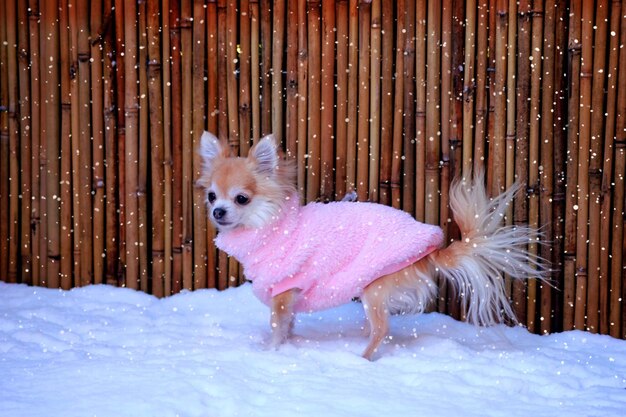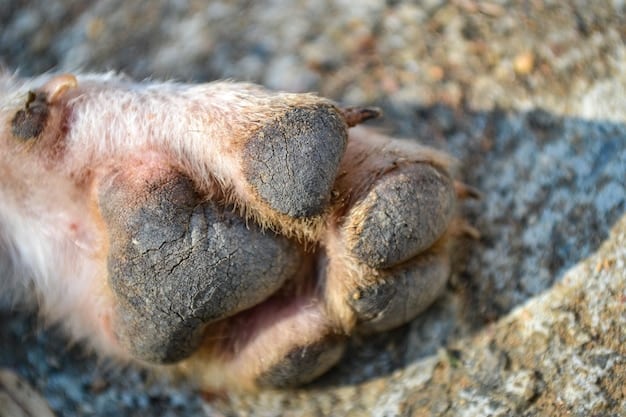Winter Pet Care: 6 Tips to Keep Your Pet Safe and Warm

Winter pet care involves ensuring your furry friends stay safe and warm during the colder months by providing adequate shelter, proper nutrition, and protection from the elements, which can include using pet-safe ice melt products, monitoring their time outdoors, and keeping them away from potential hazards like antifreeze.
As the temperature drops, it’s crucial to adjust your pet care routine to ensure your furry friends stay healthy and happy. Winter pet care: 6 essential tips to keep your furry friend safe and warm this season, will help you navigate the challenges of winter and provide the best possible care for your beloved companions.
Understanding the Risks of Winter for Pets
Winter presents several unique challenges for pets. Understanding these risks is the first step in ensuring their safety and well-being during the colder months. From hypothermia to frostbite, the winter season can be particularly dangerous for our furry companions.
Hypothermia and Frostbite
Hypothermia occurs when a pet’s body temperature drops dangerously low. Frostbite, on the other hand, happens when body tissues freeze. Both conditions can be life-threatening and require immediate veterinary attention. Knowing the signs can help you act quickly.
- Shivering excessively; a key sign of hypothermia.
- Lethargy and weakness; indicating the body is struggling to stay warm.
- Pale or bluish gums; a sign of reduced blood circulation.
- Cold extremities (ears, paws, tail); indicating potential frostbite.
Toxic Hazards
Winter often brings increased exposure to toxic substances. Antifreeze, commonly used in vehicles, is highly poisonous to pets, and even a small amount can be fatal. Rock salt and chemical de-icers used to melt snow and ice can also be harmful if ingested or if they irritate your pet’s paws.

Tip 1: Provide Adequate Shelter and Warm Bedding
Ensuring your pet has a warm and safe place to retreat from the cold is paramount. This is especially important for pets that spend time outdoors, but even indoor pets benefit from extra warmth during the winter months. Creating a cozy environment can make a significant difference in their comfort.
Outdoor Shelter
If your pet spends time outdoors, provide a well-insulated shelter to protect them from the elements. A dog house or cat shelter should be elevated off the ground and have a windproof door flap to keep out drafts. Regular checks of the shelter are essential to ensure it remains dry and warm.
Indoor Bedding
For indoor pets, ensure they have a warm and comfortable bed away from drafts. Consider adding extra blankets or a heated pet bed for added warmth. Keeping their bedding clean and dry is also crucial to prevent skin irritations and other health issues.
By providing adequate shelter and warm bedding, you create a safe haven for your pets, protecting them from the harsh realities of winter and ensuring their comfort and well-being.
Tip 2: Adjust Your Pet’s Diet for Winter
Pets often require more calories during the winter months to maintain their body heat. Adjusting their diet to meet these increased energy needs is crucial for their overall health. Proper nutrition can help them stay warm and active throughout the season.
If your pet spends a significant amount of time outdoors, consider increasing their food portions to provide extra calories for energy production. High-quality, protein-rich foods are particularly beneficial. Consult with your veterinarian to determine the appropriate amount for your pet’s specific needs.
Always provide access to fresh, unfrozen water. Dehydration can be a significant issue in winter, especially if water sources freeze. Regularly check and replenish your pet’s water bowl to ensure they stay hydrated. This is crucial for their overall health and well-being.

Tip 3: Protect Their Paws from the Elements
A pet’s paws are particularly vulnerable during winter. Exposure to snow, ice, and chemical de-icers can cause significant discomfort and potential injury. Protecting their paws is an essential part of winter pet care.
Booties and Paw Wax
Consider using booties to protect your pet’s paws from the elements. Booties provide a barrier against snow, ice, and harmful chemicals. If your pet isn’t a fan of booties, consider using paw wax, which creates a protective layer on their pads, preventing dryness and cracking.
Regular Paw Cleaning
After each outdoor excursion, clean your pet’s paws thoroughly to remove any salt, ice, or chemicals. Use a warm, damp cloth to wipe their paws and between their toes. Check for any signs of irritation, such as redness, cracking, or bleeding. Prompt treatment can prevent further complications.
Tip 4: Limit Outdoor Exposure and Monitor Time Outside
While some pets enjoy playing in the snow, prolonged exposure to cold temperatures can be dangerous. Limiting their time outdoors and closely monitoring their behavior is crucial for preventing hypothermia and frostbite. Knowing when to bring them inside can make all the difference.
Pay close attention to your pet’s behavior while they are outside. Signs of discomfort, such as shivering, whining, or lifting their paws, indicate they are getting too cold. These are clear signals that it’s time to bring them indoors. Ignoring these signs can lead to serious health issues.
Short, frequent walks are preferable to long, extended periods outdoors. This allows your pet to relieve themselves without spending too much time in the cold. Adjust walk times based on the weather conditions and your pet’s tolerance to cold.
Tip 5: Keep Your Pet Active Indoors
Winter can lead to reduced activity levels for many pets, which can result in weight gain and boredom. Keeping your pet active indoors is essential for their physical and mental well-being. Engaging activities can help them stay happy and healthy.
- Interactive games; such as fetch, tug-of-war, or hide-and-seek, can provide both physical and mental stimulation.
- Puzzle toys; filled with treats can keep them entertained for hours, challenging their problem-solving skills.
- Indoor agility courses; using household items like pillows and blankets, can provide a fun and challenging workout.
Regular playdates with other pets can also provide much-needed socialization and exercise. Ensure the play area is safe and free from hazards. Active pets are happier and healthier, even during the winter months by staying stimulated and active indoors.
Tip 6: Watch Out for Seasonal Affective Disorder (SAD)
Pets can also experience Seasonal Affective Disorder (SAD), just like humans. Reduced sunlight during winter can affect their mood and behavior. Recognizing the signs of SAD and taking steps to alleviate it can improve your pet’s quality of life.
Symptoms of SAD in Pets
Common signs of SAD in pets include increased sleeping, decreased activity levels, loss of appetite, and changes in behavior. If you notice these symptoms, it’s important to take action to improve their mood.
Combating SAD
Increase exposure to natural light by positioning their bed near a window. Use full-spectrum lights to mimic sunlight. Engage in more playtime and provide extra attention and affection. A happy and engaged pet is less likely to suffer from SAD.
Addressing their psychological needs, you can help them thrive during the winter months and maintain a positive outlook despite the challenging conditions. Watch for symptoms and adjust to increase their activity levels.
| Key Point | Brief Description |
|---|---|
| 🏠 Shelter & Bedding | Provide warm, insulated shelter and cozy bedding indoors. |
| 🐾 Paw Protection | Use booties or paw wax to protect against ice and chemicals. |
| ❄️ Limit Exposure | Monitor outdoor time to prevent hypothermia and frostbite. |
| ☀️ Combat SAD | Ensure pet gets enough sunlight and indoor activity to combat SAD. |
FAQ
▼
Shivering, whining, and seeking warm places are all signs that your pet is feeling too cold. Also, check their ears and paws; if they are cold to the touch, it’s time to bring them inside to warm up.
▼
Yes, smaller breeds and those with short coats are more vulnerable to cold temperatures. Larger breeds with thick fur tend to tolerate cold weather better, but all pets can be at risk if exposed for too long.
▼
Use a warm, damp cloth to gently wipe their paws. Pay special attention to the areas between their toes, where salt and ice can accumulate. Follow up with a dry towel to prevent chapping and irritation.
▼
Yes, just like humans, pets can get sick from the cold. Prolonged exposure can lead to respiratory issues, such as kennel cough in dogs and upper respiratory infections in cats. Keep them warm and dry to minimize this risk.
▼
Yes, antifreeze is extremely toxic and can cause kidney failure and death. Keep antifreeze stored securely and clean up any spills immediately. If you suspect your pet has ingested antifreeze, seek veterinary care immediately.
Conclusion
Ensuring your pet’s safety and comfort during winter involves several essential steps, from providing adequate shelter and adjusting their diet to protecting their paws and limiting outdoor exposure. By following these winter pet care tips, you can help your furry friend stay warm, healthy, and happy throughout the cold season.





